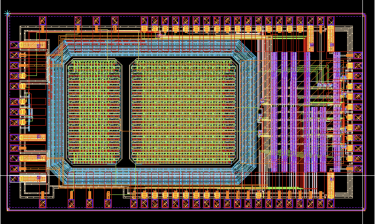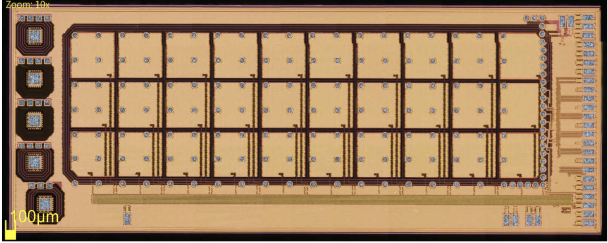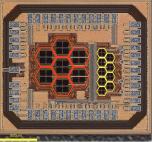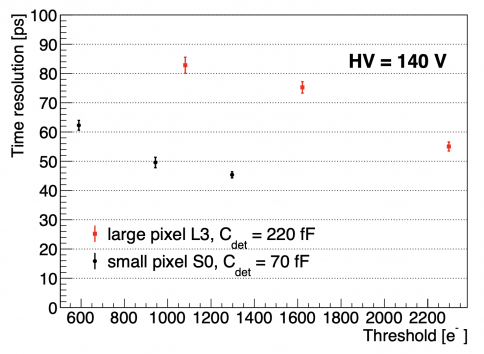Since 2015, we develop monolithic silicon pixel sensors in SiGe HBT technology for timing purposes.
After a proof-of-concept amplifier realised with discrete components, which provided 106 ps time resolution [ref] in a testbeam experiment with beams of minimum ionising particles, we started the development of monolithic ASICs with the SG13S and SG13G2 130nm node technologies of IHP Mikroelektronik.
A series of monolithic prototypes were produced, which provided full efficiency and time resolution down to 50 ps. These results are competitive with silicon technologies that integrate an avalanche mechanism, and prove that SiGe HBT technology can provide precision tracking and excellent time resolution even in the absence of an internal gain mechanism.
A first prototype [ref] in SG13S process with two pads of area 1x1 and 1x0.5 mm² . The pads, with a capacitance of approximately 1pF, were read out by a fast low-noise SiGe HBT amplifier that provided an equivalent noise charge of less than 600 e− RMS for such large capacitance, with a total time walk of less than 1 ns for minimum-ionizing particle signals. This performance was obtained with a power consumption of 350 μW/channel. The pads were measured to have a detection efficiency greater than 99% and a time resolution of approximately 200 ps. These prototypes were not subject to post-processing (thinning and back-side metallisation, to be optimised for timing.

The second prototype produced is the "TT-PET demonstrator", a complete chip made by a 3x10 matrix of 0.5x0.5mm² pixels, containing preamplifier, discriminator, 50ps binning TDC, R/O logic and serializer integrated in chip [ref]. The demonstrator, thinned down to 100 μm and backside metallized, was operated at a voltage of 180 V. The tests on a beam line of minimum ionizing particles show a detection efficiency greater than 99.9% and a time resolution down to 110 ps [ref]. For more information, please see the TT-PET Project web page.

Finally, a prototype with a sensor design optimised for timing was produced in the IHP SiGe BiCMOS SG13G2 technology. It contains small matrices of hexagonal pixels of 130 µm and 65 μm side and capacitance of approximately 220 fF and 70 fF, respectively. Single-hit rate scans performed with a 109Cd source indicate an ENC of the preamplifier of 90 electrons RMS and a gain of 290 mV/fC for the small pixels, and 160 electrons RMS and 185 mV/fC for the large pixels.
Data taken with a 90Sr source were used to measure the TOF between the prototype and a reference LGAD detector that has 50 ps time resolution. A total excursion of the time walk below 1 ns was measured, which confirms the fast response of the amplifier. At an amplifier current of 150µA and a bias voltage of 140 V, time resolutions between (62 ± 2) ps and (46 ± 1) ps were measured at different thresholds for the smaller pixels after time-walk correction [ref]. These resolutions refer to the ∼90% of the events in the Gaussian core of the distributions. No event selection was performed. Beamline experiments with an external tracking system will allow for more detailed studies and for an accurate measurement of the efficiency of this prototype.
We also measured the time resolution of this prototype as a function of the pre-amplifier current. The results [ref] show a time resolution of 140 ps at an amplifier current of 7 μA.
A full simulation showed that the resolution on the measurement of the signal time-over-threshold, used to correct for time walk, is the main factor affecting the timing performance. In future prototypes we will devise different methods for correction of the time walk, to push this technology to the limit


This research is presently continuing within the framework of the MonPicoAD H2020 ATTRACT project and from July 2020 of the MONOLITH H2020 ERC Advanced project.
Group contributors:
Giuseppe Iacobucci, Lorenzo Paolozzi, Pierpaolo Valerio, Roberto Cardella, Magdalena Munker, Fulvio Martinelli, Didier Ferrére, Stéphane Debieux, Yannick Favre, Antonio Picardi, Matteo Milanesio, Chiara Magliocca
Former members:
Daiki Hayakawa, Emanuele Ripiccini, Francesco di Bello, Ettore Zaffaroni, Gennaro Bottino, D.M.S. Sultan
Supported by:




Recent Papers:
-
Efficiency and time resolution of monolithic silicon pixel detectors in SiGe BiCMOS technology
G. Iacobucci et al.
JINST P02019 (P02019) (2022) [arXiv]
-
Measurements and analysis of different front-end configurations for monolithic SiGe BiCMOS pixel detectors for HEP applications
F. MARTINELLI et al.
Journal of Instrumentation 16 (P12038) (2021) [arXiv] -
Monolithic Picosecond Silicon Pixel Sensors for Future Physics: Experiments and Applications
Giuseppe IACOBUCCI, Lorenzo PAOLOZZI, Pierpaolo VALERIO
IEEE Instrumentation & Measurement Magazine 24 (9) 5-11 (2021) -
A massively scalable Time-to-Digital Converter with a PLL-free calibration system in a commercial 130 nm process
F. MARTINELLI et al.
JINST 16 (P11023) (2021)
-
Time resolution and power consumption of a monolithic silicon pixel prototype in SiGe BiCMOS technology
L. PAOLOZZI et al.
JINST P11025 (P11025) (2020) [arXiv]
-
A 50 ps resolution monolithic active pixel sensor without internal gain in SiGe BiCMOS technology
Iacobucci G. et al.
JINST 14 (P11008) (2019) [arXiv]
-
A monolithic ASIC demonstrator for the Thin Time-of-Flight PET scanner
Valerio P. et al.
JINST 14 (P07013) (2018) [Other link] [arXiv] -
Characterization of the demonstrator of the fast silicon monolithic ASIC for the TT-PET project
Paolozzi L. et al.
JINST 14 (P02009) (2018) [Other link] [arXiv] -
Module concept and thermal studies of the silicon-based TT-PET small-animal scanner,
Ferrere D. et al.
submitted to JINST (2018) [arXiv] -
E. Ripiccini et al., “Expected performance of the TT-PET scanner,” https://arxiv.org/abs/1811.12381, 2018.
Ripiccini E. et al.
(2018) [arXiv] -
Test beam measurement of the first prototype of the fast silicon pixel monolithic detector for the TT-PET project
L. PAOLOZZI et al.
JINST 13 (P04015) (2018) [arXiv]
-
100 ps time resolution with thin silicon pixel detectors and a SiGe HBT amplifier
M. BENOIT et al.
JINST 11 P03011 (2016) [arXiv]
